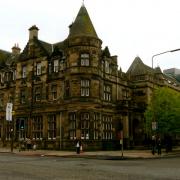
These are not easy times for public libraries. Budgetary constraints and changing technological media are just two of the challenges facing all councils as they seek to connect people with the information and culture they require.
Edinburgh's 'Next Generation Library and Information Services Strategy 2012–2015' has been published recently, and readers have until 31 January to submit comments. (You can download it from the file below.)
Having read it, Spurtle is torn between conflicting reactions. On the one hand, of course we want our libraries to be modern, attractive, financially well managed, appropriately located and fit for purpose.
On the other, we're not sure whether those authors of the Strategy who claim it 'encourages evolution of high quality, joined up service delivery located within communities, inviting user participation in the development of services to ensure we meet customer demands and based on the delivery of service excellence' really remember what a library is. We're not sure we would either if we'd just eaten an entire, 15-volume Dictionary of Joy-Lite Local Authority Gobbledegook.
Key to our understanding of a library is a distinct, specialist building employing specialist library staff to enable and enthuse readers of all abilities with as wide a range of interests as possible.
Key to the Council's Strategy is a 'hub' approach which will see 'the development of libraries as part of a joint service at local level where the community can access a range of neighbourhood and information services; a seamless delivery model which provides best value use of physical buildings and assets within the community. Hubs can involve cross council services as well as a shared service opportunity with other Partners'.
With the best will in the world, that sounds less like improving the library service and more like changing it out of all recognition. Worse, it sounds like reincarnating the Council's hopeless and widely derided Outlook propaganda magazine in breezeblock and plasterboard partitions.
No-one could argue against 'Improved literacy and digital skills and enhanced love of reading' as one of the Strategy's key outcomes, but this is largely in order to promote young people's 'employability'. Any hopes for empowering and motivating are directed at library staff, not at igniting the imaginations and ambitions of all generations, giving them access to a world of knowledge and inspiration beyond the dreary confines of bureaucratic improvement programmes.
To our mind, the best section of the Strategy is that dealing with Resources. Here, the 'key drivers' are listed as being to:
- Promote literacy and reading to enhance the quality of life
- Connect people with information to help them learn, make informed choices, and enjoy their leisure time
- Support cultural life, understanding of our heritage, and Edinburgh’s economy
- Foster a sense of identity and community
- Safeguard people’s access to intellectual and cultural diversity.
However, just as the authors begin to scale the foothills of inspiration, they turn around and waddle back into the gurgling bogs of management-ese. 'What will be different?' they ask. The answer: 'Easy access to high quality, well-managed stock with local resources appropriate to the community and size of the library' for which read a mealy-mouthed euphemism for value for money.
Perhaps Spurtle is out of touch with the realities of 21st-century public resources. Perhaps we aspire to more verbal pyrothechnics in a Council document than it is reasonable to expect. But libraries ought to be exciting. Surely, somewhere in their institutional DNA should be a code which states that they exist to help people find more great stories, powerful words, liberating ideas and world-defining facts than they would ever find by themselves.
Libraries are potential life-changers, and the resources devoted to them and the language used to define them should confidently assert that. AM
[Image © Copyright kim traynor and licensed for reuse under this Creative Commons Licence.]